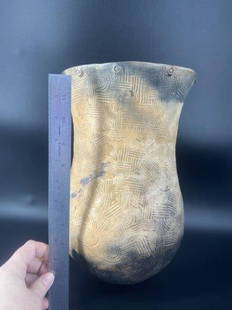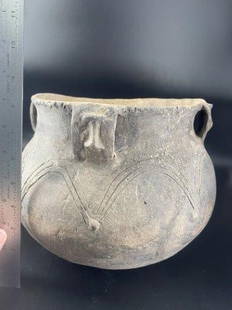
Spanish school; century XVIII. "Saint Antony". Carved and polychrome wood.
Similar Sale History
View More Items in Tribal & Native American Artifacts
Related Tribal & Native American Artifacts
More Items in Tribal & Native American Artifacts
View MoreRecommended Art
View More







Item Details
Description
Spanish school; 18th century.
"Saint Anthony".
Carved and polychrome wood.
Measurements: 47 x 36 x 7 cm.
Relief in wood of a devotional nature, showing Saint Anthony. This work represents one of his most famous visions: either in an inn or in a house, the owner of the house saw through the half-open door how the saint was talking to a beautiful child, whom he was holding in his arms. However, in this case we can only see the presence of the Infant Jesus in the upper area, without the saint actually holding him. This iconography has generally been used since the 17th century, becoming so well known and appreciated that no other element was needed to identify the subject, as can be seen in the present work.
Saint Anthony of Padua is, after Saint Francis of Assisi, the most popular of the Franciscan saints. He was born in Lisbon in 1195 and only spent the last two years of his life in Padua. After studying at the convent of Santa Cruz in Coimbra, he entered the Order of Friars Minor in 1220, where he changed his Christian name from Fernando to Antonio. After teaching theology in Bologna, he travelled through southern and central France, preaching in Arles, Montpellier, Puy, Limoges and Bourges. In 1227 he took part in the general chapter at Assisi. In 1230 he was involved in the transfer of the remains of St. Francis. He preached in Padua and died there at the age of 36 in 1231. He was canonised only a year after his death, in 1232. Until the end of the 15th century, the cult of St. Anthony remained located in Padua. From the following century onwards, he became, at first, the national saint of the Portuguese, who placed the churches they built abroad under his patronage, and then a universal saint. He is depicted as a beardless young man with a broad monastic tonsure, dressed in the brown habit of the Franciscans. One of his most frequent attributes is the book, which identifies him as a sacred writer. Another distinctive iconographic feature is the branch of lily, an element borrowed from his panegyrist Bernardine of Siena. Saint Anthony is often depicted with the Infant Jesus, alluding to an apparition he had in his cell. It became the most popular attribute of this saint from the 16th century onwards, and was particularly popular in the Baroque art of the Counter-Reformation.
"Saint Anthony".
Carved and polychrome wood.
Measurements: 47 x 36 x 7 cm.
Relief in wood of a devotional nature, showing Saint Anthony. This work represents one of his most famous visions: either in an inn or in a house, the owner of the house saw through the half-open door how the saint was talking to a beautiful child, whom he was holding in his arms. However, in this case we can only see the presence of the Infant Jesus in the upper area, without the saint actually holding him. This iconography has generally been used since the 17th century, becoming so well known and appreciated that no other element was needed to identify the subject, as can be seen in the present work.
Saint Anthony of Padua is, after Saint Francis of Assisi, the most popular of the Franciscan saints. He was born in Lisbon in 1195 and only spent the last two years of his life in Padua. After studying at the convent of Santa Cruz in Coimbra, he entered the Order of Friars Minor in 1220, where he changed his Christian name from Fernando to Antonio. After teaching theology in Bologna, he travelled through southern and central France, preaching in Arles, Montpellier, Puy, Limoges and Bourges. In 1227 he took part in the general chapter at Assisi. In 1230 he was involved in the transfer of the remains of St. Francis. He preached in Padua and died there at the age of 36 in 1231. He was canonised only a year after his death, in 1232. Until the end of the 15th century, the cult of St. Anthony remained located in Padua. From the following century onwards, he became, at first, the national saint of the Portuguese, who placed the churches they built abroad under his patronage, and then a universal saint. He is depicted as a beardless young man with a broad monastic tonsure, dressed in the brown habit of the Franciscans. One of his most frequent attributes is the book, which identifies him as a sacred writer. Another distinctive iconographic feature is the branch of lily, an element borrowed from his panegyrist Bernardine of Siena. Saint Anthony is often depicted with the Infant Jesus, alluding to an apparition he had in his cell. It became the most popular attribute of this saint from the 16th century onwards, and was particularly popular in the Baroque art of the Counter-Reformation.
Buyer's Premium
- 26%
Spanish school; century XVIII. "Saint Antony". Carved and polychrome wood.
Estimate €5,500 - €6,000
2 bidders are watching this item.
Get approved to bid.
Shipping & Pickup Options
Item located in Barcelona, -, esSee Policy for Shipping
Payment

TOP















































































